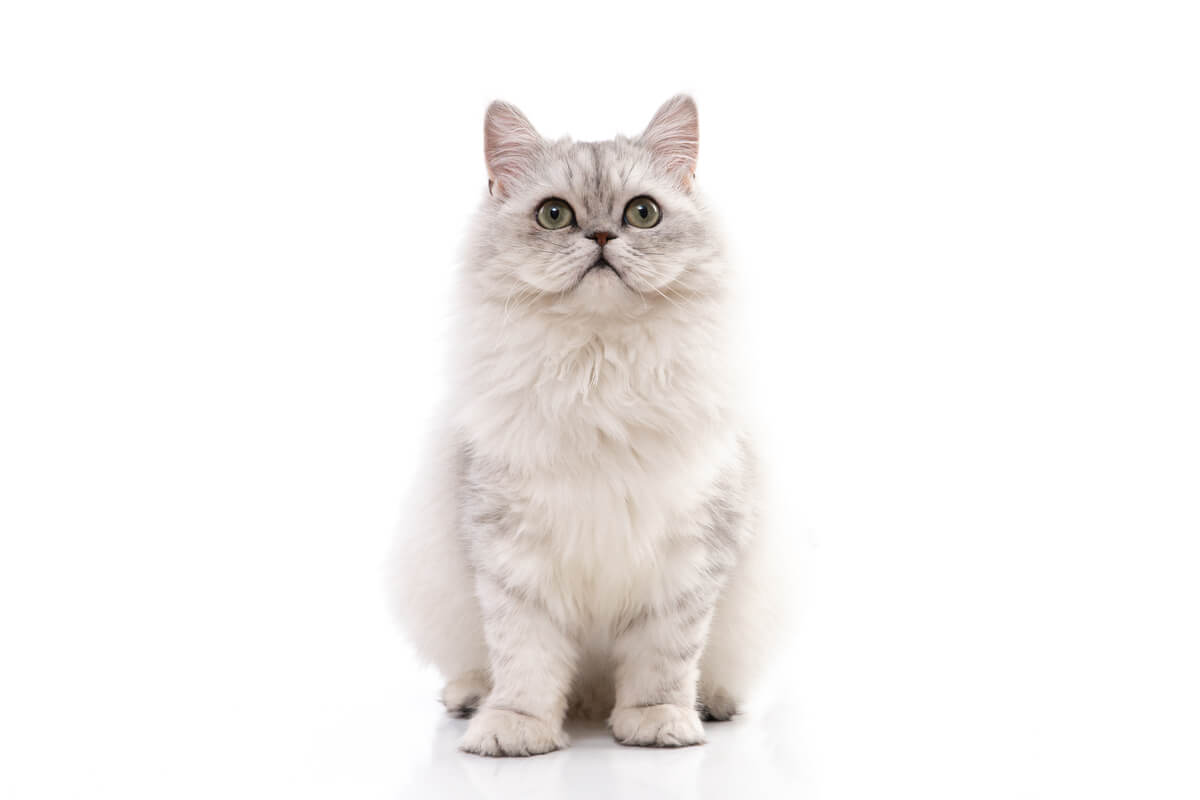How to Bathe a Persian Cat in 6 Steps


Reviewed and approved by the biologist Samuel Sanchez
Persians, known for being friendly cats that love naps and rest, can become stressed or scared at bath time if not treated with the utmost care. That’s why we’d like to bring you six steps to bathe a Persian cat, understanding that every detail counts if you want your feline to feel comfortable in this important cleaning process.
It’s essential for you to find a quiet place without cold wind or draughts, so that your Persian cat can have a pleasant environment to be groomed in without any complications. If you have a feline of this breed, then you’ll soon know how to bathe it without any problems. Follow the steps that we’re going to show you.
1. Brush their hair well
To begin with, it’s important to keep in mind that these cats are a breed with long, abundant hair, so the first step in bathing a Persian cat is to give its coat a good brush. Only then will you ensure that it doesn’t have any knots.
Otherwise, after wetting and drying it, it’ll be much more difficult to untangle its fur and, in addition, you would run the risk of hurting your cat. Having to exert pressure on their fur is never a good option, as it will be an unpleasant experience for the cat and it may even attack its owner.

2. Get the cat used to water
If your Persian cat is a kitten, it may be easier for them to adapt to being bathed, but for an adult it’ll be a lot more difficult. However, regardless of age, you must ensure that this short-nosed feline doesn’t shy away when it comes to touching the water and continues to have the calm and friendly demeanor that so sets it apart.
To ensure this, you’ll need to get your cat used to the idea of water. If you follow these steps, your cat will surely lose its fear from a young age:
- Place the animal in its future bathtub regularly, if possible every day. Don’t pour any water in, but let it get used to the environment and play with it. In other words, use positive reinforcement.
- Little by little, introduce a cloth with warm water into the equation. Don’t get the cat totally wet and don’t do it every day, but let it get used to sporadic grooming.
- If everything goes well after the period of habituation, you can place a little warm water in the bottom of the bathtub and gradually wet the animal with a cup.
- Don’t stop using positive reinforcement throughout the process. If the cat behaves well, reward them.
3. Be careful with the temperature
Another fundamental step in bathing a Persian cat is to use warm water – not too cold, not too hot – to make the process more comfortable and pleasant. Once you have the water at the ideal temperature, you can begin to wet the feline little by little.
Keep in mind that the usual body temperature of cats is 38º to 39ºC. This is a couple of degrees higher than humans.
4. Shampoo time
When the Persian cat is wet (but calm!) you can apply shampoo and massage their hair carefully without getting the product in their eyes or ears. In the same way, and after having removed the product, you can add conditioner or apply a second coat of shampoo if the cat’s quite dirty and needs it.
Keep in mind that the products you apply must be specifically for cats, and, if possible, be especially for a Persian cat’s coat, as this is one of the most striking characteristics of this breed. If you have any questions about the appropriate brand, don’t hesitate to consult your vet.
5. More water
After having applied what you need to massage and clean your Persian cat, use some more warm water and remove the products without letting them fall on the cat’s face, to avoid irritation or unnecessary affectations. Remember to get them wet slowly so you don’t scare them off, but also make sure that no shampoo residue is left on their body.
6. Dry and brush!
It’s best to use two clean towels to dry the cat. With the first, remove the excess water. Then use the second to warm it up and massage it well until it’s completely dry.
Also, remember that the Persian has a coat that requires special care. For this reason, you’ll have to brush the feline again once it has finished its bath. Make sure you use a suitable comb to detangle the Persian cat’s hair without harming it.
According to this research cats use hollow papillae to absorb saliva in their fur. Domestic cats can spend up to 24% of their waking time grooming their fur, they found. Grooming helps the cat remove pesky fleas, loose hair, and excess heat.
With this information, we can assume that these cats shouldn’t be bathed frequently, since most of the time they are licking their fur and grooming themselves. Do it only when strictly necessary.

So, in conclusion, we recommend you bathe your Persian cat once a month or once every two months, putting into practice the six steps previously we’ve in order to prevent this friendly feline from getting diseases or complications in its health and hygiene. If you do it right, bathing can even be a fun time for your pet.
Persians, known for being friendly cats that love naps and rest, can become stressed or scared at bath time if not treated with the utmost care. That’s why we’d like to bring you six steps to bathe a Persian cat, understanding that every detail counts if you want your feline to feel comfortable in this important cleaning process.
It’s essential for you to find a quiet place without cold wind or draughts, so that your Persian cat can have a pleasant environment to be groomed in without any complications. If you have a feline of this breed, then you’ll soon know how to bathe it without any problems. Follow the steps that we’re going to show you.
1. Brush their hair well
To begin with, it’s important to keep in mind that these cats are a breed with long, abundant hair, so the first step in bathing a Persian cat is to give its coat a good brush. Only then will you ensure that it doesn’t have any knots.
Otherwise, after wetting and drying it, it’ll be much more difficult to untangle its fur and, in addition, you would run the risk of hurting your cat. Having to exert pressure on their fur is never a good option, as it will be an unpleasant experience for the cat and it may even attack its owner.

2. Get the cat used to water
If your Persian cat is a kitten, it may be easier for them to adapt to being bathed, but for an adult it’ll be a lot more difficult. However, regardless of age, you must ensure that this short-nosed feline doesn’t shy away when it comes to touching the water and continues to have the calm and friendly demeanor that so sets it apart.
To ensure this, you’ll need to get your cat used to the idea of water. If you follow these steps, your cat will surely lose its fear from a young age:
- Place the animal in its future bathtub regularly, if possible every day. Don’t pour any water in, but let it get used to the environment and play with it. In other words, use positive reinforcement.
- Little by little, introduce a cloth with warm water into the equation. Don’t get the cat totally wet and don’t do it every day, but let it get used to sporadic grooming.
- If everything goes well after the period of habituation, you can place a little warm water in the bottom of the bathtub and gradually wet the animal with a cup.
- Don’t stop using positive reinforcement throughout the process. If the cat behaves well, reward them.
3. Be careful with the temperature
Another fundamental step in bathing a Persian cat is to use warm water – not too cold, not too hot – to make the process more comfortable and pleasant. Once you have the water at the ideal temperature, you can begin to wet the feline little by little.
Keep in mind that the usual body temperature of cats is 38º to 39ºC. This is a couple of degrees higher than humans.
4. Shampoo time
When the Persian cat is wet (but calm!) you can apply shampoo and massage their hair carefully without getting the product in their eyes or ears. In the same way, and after having removed the product, you can add conditioner or apply a second coat of shampoo if the cat’s quite dirty and needs it.
Keep in mind that the products you apply must be specifically for cats, and, if possible, be especially for a Persian cat’s coat, as this is one of the most striking characteristics of this breed. If you have any questions about the appropriate brand, don’t hesitate to consult your vet.
5. More water
After having applied what you need to massage and clean your Persian cat, use some more warm water and remove the products without letting them fall on the cat’s face, to avoid irritation or unnecessary affectations. Remember to get them wet slowly so you don’t scare them off, but also make sure that no shampoo residue is left on their body.
6. Dry and brush!
It’s best to use two clean towels to dry the cat. With the first, remove the excess water. Then use the second to warm it up and massage it well until it’s completely dry.
Also, remember that the Persian has a coat that requires special care. For this reason, you’ll have to brush the feline again once it has finished its bath. Make sure you use a suitable comb to detangle the Persian cat’s hair without harming it.
According to this research cats use hollow papillae to absorb saliva in their fur. Domestic cats can spend up to 24% of their waking time grooming their fur, they found. Grooming helps the cat remove pesky fleas, loose hair, and excess heat.
With this information, we can assume that these cats shouldn’t be bathed frequently, since most of the time they are licking their fur and grooming themselves. Do it only when strictly necessary.

So, in conclusion, we recommend you bathe your Persian cat once a month or once every two months, putting into practice the six steps previously we’ve in order to prevent this friendly feline from getting diseases or complications in its health and hygiene. If you do it right, bathing can even be a fun time for your pet.
All cited sources were thoroughly reviewed by our team to ensure their quality, reliability, currency, and validity. The bibliography of this article was considered reliable and of academic or scientific accuracy.
- David L. Hu, Alexis C. Noel. (2018). Los gatos usan papilas huecas para absorber la saliva en el pelaje. Procedimientos de la Academia Nacional de Ciencia
- Grupo PM. (2011). Enciclopedia Felina
- O’Neill, D. G., Romans, C., Brodbelt, D. C., Church, D. B., Černá, P., & Gunn-Moore, D. A. (2019). Persian cats under first opinion veterinary care in the UK: demography, mortality and disorders. Scientific reports, 9(1), 1-13.
- Gagne, T. (2017). Persian Cats. Weigl Publishers.
- Bertolini, F., Gandolfi, B., Kim, E. S., Haase, B., Lyons, L. A., & Rothschild, M. F. (2016). Evidence of selection signatures that shape the Persian cat breed. Mammalian Genome, 27(3-4), 144-155.
This text is provided for informational purposes only and does not replace consultation with a professional. If in doubt, consult your specialist.








